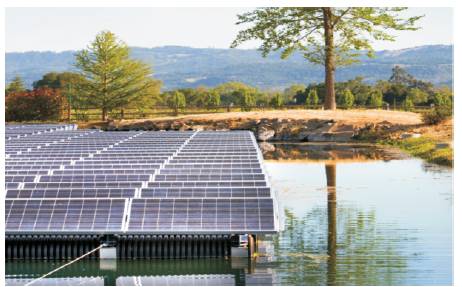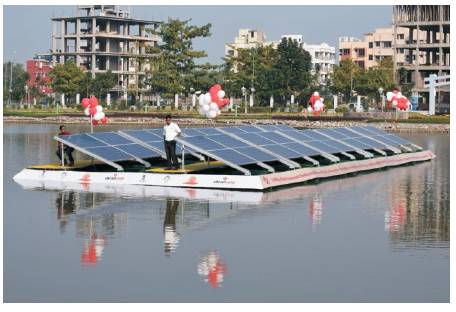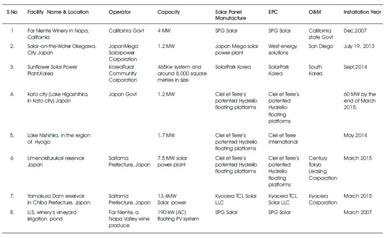
Figure 1. Global Annual Installation of Solar Energy
Photovoltaic systems have been successfully deployed on land and roof top of buildings. But, over the past five years , solar panels have been installed on water surfaces like ponds, reservoirs and canals even on oceans in order to reduce the land occupied by solar panels for power generation. The added advantage of floating solar power plants is that the temperature of solar panels will be within the limits, due to their location near to water, as they are installed on water bodies (reservoirs, lakes.etc) .
In this paper, objectives of floating solar panels with their pros and cons are presented in section 1. Section 2 gives the technical details of floating structures and panels, Installation capacities of worldwide floating solar power plants and also upcoming projects of floating solar power plants in India, presented in section 3.
1. Objectives of Solar Plants
1.1 Benefits of Solar Power Plants
- Floating solar power plants are installed on water surfaces so these panels are naturally cooled, thus the temperature rise of panels is less compared to roof top solar power panels. The life time of panels increases due to less stress on the panels.
- Floating solar panels cost slightly higher than the roof top solar panels. In situations where the availability of land is a major issue, the floating plants offer a better option in that land can be utilized better by saving space.
- The floating solar power systems also provides another environmental benefit: prevention of evaporation of water. (As an example, the Floating solar system shades the water and can reduce evaporation by up to 70%. A 3-acre storage pond covered with solar panels could save over 4 million gallons of water each year.)
- The systems can also improve water quality. Solar panels acts as roof for the water bodies. So the water will not exposed to sun and atmosphere, thus it is advantageous to water treatment plants.
- The organic matter growth such as algae will decrease, as solar panels acts as cover to water bodies. It will minimize the labor cost of water treatment plant maintenance.
1.2 Challenges for Floating Power Plants
The major problems associated with the floating solar power plants are the material used for the floating structures.
- For floating solar power plants the structure have to continuously exposed to water, due to which it may cause some adverse environmental effects. (polluting the water due to chemical reaction).
- If metallic structure is used for floating solar system, it should have high corrosion resistance otherwise, it will cause adverse environmental problems in water bodies.
- The transmission of generated power from floating solar panels to distribution networks is major challenge associated with floating solar power plants.
2. Technical Details of Structures and PV Panels
The construction of a floating system consists of the major parts as,
- Floating structures
- PV panels
- Inverter Mechanism
- Transmission of power to grid.
- Control Mechanism
- Monitoring Mechanism [1].
The energy generated by floating power plant can be transmitted to load or grid by cable submerged in water. Proper planning is required to produce the electric power by using floating solar power plants without in any way disturbing the existence of the water body.
By using proper software and remote control mechanism monitoring of plant elements like metrological parameters and floating platform parameters are possible, and so also control, to monitor malfunctions, starting and stopping of the functioning of the plant.
2.1 Structures
The structure should easily adapt to changes in water level in reservoirs. i.e, irrespective of water levels, the system should float on the water bodies. The floating material should be completely recyclable.
The main characteristics of these structures should be,
- The materials used for structure should be completely non toxic, resistant to salt water and alkalis acids, Ultra Violet (UV) rays resistant and completely recyclable.
- The structures should be able to withstand temperatures from -60°C to 80°C.
- Long life time i.e, 30 years under water.
- The structure should be modular so that it can be removable and replaceable.
Main materials for the modules of structures are Plastic float elements and stainless steel elements. The plastic structures are made of LUPOLEN 5261Z or PEAD materials which are used for construction of jetties both in marine and military fields. The cost of PEAD material is high. The other material suitable for floating solar system is HDPE (High Density Poly Ethylene) material. These HDPE structures are preferred due to their low cost and high reliability.
The other type of structures are metal support structures for photovoltaic panels, they are made of tubular Zinc coated stainless steel sections. The cost of metal structures is high and the other drawback of metal bodies are less resistance to alkalis and acids.
Due to drawbacks and cost considerations of other materials HDPE [6,7] material is most commonly used for the floating solar systems. High Density polyethylene structure is shown in Figure 2. It allows standard PV panels to be installed on large bodies of water such as drinking water reservoirs, quarry lakes, irrigation canals or remediation and tailing ponds.

Figure 2. HDPE Structure for Floating Power Plant
The Life time of HDPE structures of floating solar power plants is more than 20 years.
The main properties of HDPE are,
- 1. Resistant to UV radiation and corrosion: The structures are made of HDPE through blow mold manufacturing process. It is also very durable.
- 2. Extremely resistant to winds: HDPE Structures floating solar power can withstand winds of speed upto 118 mph according to Office National of d’Etuses et de Recherches Aerospatiales (ONERA)- the French aerospace lab report.
- 3. Safe mounting and maintenance: It has been designed to be easily and quickly deployed. The secondary floats allow easy access to the panels for maintenance and cleaning.
- 4. Drinking water compliant: Drinking water compliance tested by the English Independent Water Quality Control Center.
- 5. Cost-effective: Cost is less per module compared to LUPOLEN 5261Z, and Zinc coated stainless steel structures.
The other manufacturing benefits of HDPE structures are easiness of installation, i.e, easy to adapt to any electrical configuration, scalable from low to high power generation, does not require heavy equipment for installation of HDPE structures. Recycling is possible for HDPE materials.
2.2 Solar or PV Panel
Different types of solar panels are available nowadays. The power generating capacity is major concern while selecting the panels. Generally, these PV panels are classified as poly, mono, thin film or hybrid panels. The panel efficiency determines the space occupied by solar panel for a given power generation capacity.
Most crystalline modules (whether monocrystalline or polycrystalline) will perform very similarly, and will take up roughly the same space.
Hybrid panels are definitely a cut above crystalline ones in terms of efficiency, which means that they generate a larger power from a smaller area. However, they are too expensive compared to crystalline panels and are really not worthwhile.
Thin film modules are best, and also they are very well suited to dull, diffuse conditions [5]. They take up a lot more room than other types, but durability is very less. The cost of solar panels also depends on location of manufacturing and transport charges. The three types of solar panels are,
- 1) Mono crystalline panels
- 2) Polycrystalline panels
- 3) Hybrid panels,
2.2.1 Monocrystalline Panels
The solar cells in monocrystalline panels are slices cut from pure drawn crystalline silicon bars [8]. The entire cell is aligned in one direction, which means that, when the sun is shining brightly on them at the correct angle, they are extremely efficient. So, these panels work best in bright sunshine with the sun is shining directly on them.
They have a uniform black color because they are absorbing most of the light. Pure cells are octagonal, so there is unused space in the corners when lots of cells are made into a solar module. Monopanels are slightly smaller than poly panels for the same power, but this is observable only on industrial scale installations. Figure 3 shows the structure of mononcrystalliine panels and Figure 4 shows the structure of multicrystalline panels.

Figure 3. Structure of Mononcrystalliine Panels

Figure 4. Structure of Multicrystalline Panels
2.2.2 Polycrsytalline Panels
The polycrystalline panels are also known as multicrystalline panel. Polycrystalline panels are made from the silicon off cuts, molded to form blocks and a cell made up of several bits of pure crystal is created [10]. Because the individual crystals are not necessarily perfectly aligned together and there are losses at the joints between them, they are not quite as efficient. However, this misalignment can help in some circumstances, because the cells work better from light at all angles, in low light, etc. The panels look a little bluer as they reflect some of the light. Since they are cut into rectangular blocks, there is very little wasted space on the panel. These panels have more uniform appearance with their rectangular shape. The Figure 4 shows the structure of multicrystalline pannels.
2.2.3 Hybrid Panels
The Hybrid module has a thin layer of amorphous solar film behind the monocrystalline cells. The extra amorphous layer extracts even more energy from the available sunlight, particularly in low light conditions. These are the most efficient panels available, so they take up the least space for roof and floating panels. Figure 5 shows the structure of hybrid pannels.

Figure 5. Structure of Hybrid Panels
3. Floating Solar Power Plants Across World and India
3.1 First Floating Solar Power Plant
The world's first floating photovoltaic system was installed in 2007 by SPG Solar ( Novato, California) on a pond at Far Niente Winery in Napa California [3]. It contains1,000 floating panels linked to 1,300 stationary panels on land to produce a total of 4 MW. In Napa of California most of land are used for wine fields. So, the Floating solar system is chosen to secure the land used for power generation.
Figure 6 shows the photo of world's first floating power plant. Figure 7 gives the Floating Tracking Cooling Concentrator (FTCC) system in Colignola on the outskirts of Pisa. Each PV panel is positioned between two reflectors tilted at angles of 60 degrees.

Figure 6. Photo of Worlds First Floating Power Plant

Figure 7. Floating Tracking Cooling Concentrator (FTCC) System in Colignola on the Outskirts of Pisa

Figure 8. Photo of 7.5 MW Solar Floating Power Plant on Umenokifurukori Reservoir
3.2 World's Largest Floating Solar Power Plant
Japan is planning to develop a 7.5 MW solar power plant on surface of Umenokifurukori reservoir. Japan has also planned to install a 13.4 MW floating solar power plant on the Yamakura dam reservoir in Chiba Prefecture. A total capacity of 1.7 Megawatts (MW) installed on Lake Nishihira, in the region of Hyogo [4]. Figure 8 shows a picture of 7.5 MW solar floating power plant on Umenokifurukori reservoir.
A second floating solar power plant in Japan was installed with a capacity of 1.2 MW on Lake Higashihira, in Kato city, The aim of Japan is to install floating solar plants with a total capacity of 60 MW by the end of March 2015.
3.3 Other Minor Floating Solar Power Plants
3.3.1 Floating Solar Power Plant on the Water Okegawa Reserviour
The floating solar power plant was installed in Japan at Okegava in June2014, with a generating capacity of 1.18- MW[9]. The system is named as Solar on the Water Okegawa. Due to the issues of land shortage and of protecting natural and agricultural lands, Japan has decided to install floating solar power plants on inland water reservoirs, which are located near grid-connection. The 1.18 MW floating solar power plant has been commissioned in three months time, which contain 4500 PV modules. The Figure 9 shows photo of Solar on the water Okegawa. The Okegawa project withstood three typhoons in Japan. Due to the cooling effects of water, its floating PV systems generate about 10 percent more electricity than rooftop or ground-mounted systems of the same size.

Figure 9. Photo of Solar on the Water Okegawa
This solar power structure can withstand up to 118 mph winds and changes in water levels of up to 20 feet. It was developed by Ciel el Terre (France), which has been developing large-scale PV systems mainly in France since 2006 .
3.3.2 PV System on Kotani Dam via Hyogo Prefecture
In west of Japan, Hyogo prefecture is also looking to the water bodies for installation of solar panels. The prefecture has the largest number of irrigation ponds. Inorder to save the irrigation land they planned floating solar plants. Installation of Kotani Dam floating power plant was done in July 2014. It was developed by installation of two 20-kW systems, which differ in panel tilts and anchorage methods, to test effects of wind and waves on electricity generation. o One system has 10 tilt and the four corners of the system are anchored on the land via cable while the other system o has a 20 tilt and is anchored at the bottom of the pond with weights. Figure 10 shows the Floating solar power plant of Kotani Dam via Hyogo Prefecture. Figure 11 shows the photo of floatovltaie system at winery via far nichie.

Figure 10. Image of PV System on Kotani Dam via Hyogo Prefecture

Figure 11. Photo of Floatovoltaic System at Winery via Far Niente
Table 1 gives the data of floating solar power plants across the world.
3.3 Future for Floating Solar Systems in India
A prototype of India's first floating solar power station was installed at pond of Victoria Memorial. A raft like platform fitted with hollow plastic or tin drums would be floating on water. The power generating equipment such as solar panels would be fitted on this raft so that they can float on water.
The prototype would be able to generate 10 KW of power and would require an area of around 100 sq metres. The project was funded by ministry of power and renewable energy, it would be the first floating power system project in India. The cost of the project is 32 lakh rupees sanctioned by ministry power and renewable energy sources. The project was commissioned by Vikram Solar's in cooperation with the Arka Renewable Energy College in Kolkata [2].
The installation is completely flexible and consists of ten 1 kW fibre glass modules, which make up the floating platform itself. The system is firmly anchored to the bottom of the lake and is connected to the grid using a submersible cable. The overall system is designed to last for 25 years and produce a minimum generation of 14 MWh/year.
Figure 12 shows India's first floating solar power station launched in Victoria Memorial's ponds commissioned in 2014.

Figure 12. India's First Floating Solar Power Station Launched in Victoria Memorial's Ponds in 2014
Indian Government already started on their plan to install 10 megawatt (MW) solar plants on top of several canals, India has taken the creative use of space one step further and is planning a floating power station on one of the large stretches of water in Kerala, a state in south-western India.
This floating solar power technology was developed by India's Renewable Energy College and the plant is being built by the Indian energy company, the National Hydro Power Corporation (NHPC). The first plant is scheduled to be commissioned in October 2015.
Conclusion
With advancements in renewable energy technology becoming increasingly more important, the floating solar power plants are a great advancement in photovoltaic technology of power generation. The benefits of using floating PV systems has the water-cooling effect on silicon solar cells, the natural reflectivity of the water surface, the potential reduction in algae growth due to reduced sunlight penetration, and a lower water temperature in the areas below the arrays. This technology is durable, cost effective and flexible. It takes less time for installation. ( i.e A 200 kW system with 800 floating panels can be installed in a week time).This paper presents the advantages and challenges for floating solar power plants with technical details of structures for the floating solar power systems.
